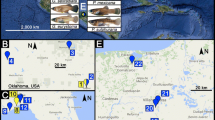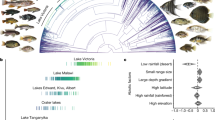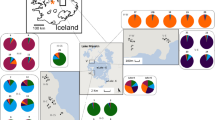Abstract
Assessment of the distribution and diversity of free-living protists is currently hampered by a limited taxonomic resolution of major phyla and by neglecting the significance of spatial and temporal scaling for speciation. There is a tremendous physiological and ecological diversity that is hidden at the morphological level and not apparent at the level of conserved genes. A conceptual framework linking the various levels of diversity is lacking. Neutral genetic markers are useful indicators of population structure and gene flow between populations, but do not explain adaptation to local habitat conditions. The correspondence between protein-coding genes, ecophysiological performance, and fitness needs to be explored under natural conditions. The area and the associated typical temporal dimension of active cells (their ‘home range’) are much smaller, respectively shorter, than the area and time period potentially covered during passive dispersal of protist resting stages. The assumptions that dispersal rates are generally high in free-living protists and that extinction of local populations is, therefore, infinitesimally small wait rigorous testing. Gene flow may be uncoupled largely from dispersal, because local adaptation and numerical effects of residents may strongly reduce or even prevent successful invasion (immigration). The significance of clonal selection depends on the as yet unknown frequency and timing of sexual reproduction, and on the stability of the environment. The extent of local adaptation and the fitness-related ecophysiological divergence are critical for the speciation process and, hence, for defining protist species.

Similar content being viewed by others
References
Amato A, Kooistraa WHCF, Ghiron JHL et al (2007) Reproductive isolation among sympatric cryptic species in marine diatoms. Protist 158:193–207
Bachmann K (1998) Species as units of diversity: an outdated concept. Theory Biosci 117:213–230
Barth D, Krenek S, Fokin SI et al (2006) Intraspecific genetic variation in Paramecium, revealed by mitochondrial COI sequences. J Eukaryot Microbiol 53:20–25
Bell G (2001) Neutral macroecology. Science 293:2413–2418
Bloem J, Bär-Gilissen M-JB, Cappenberg TE (1986) Fixation, counting, and manipulation of heterotrophic nanoflagellates. Appl Environ Microbiol 52:1266–1272
Boenigk J, Stadler P, Wiedlroither A et al (2004) Strain-specific differences in the grazing sensitivities of closely related ultramicrobacteria affiliated with the Polynucleobacter cluster. Appl Environ Microbiol 70:5787–5793
Boenigk J, Pfandl K, Stadler P et al (2005) High diversity of the ‘Spumella-like’ flagellates: an investigation based on the SSU rRNA gene sequences of isolates from habitats located in six different geographic regions. Environ Microbiol 7:685–697
Boenigk J, Pfandl K, Garstecki T et al (2006) Evidence for geographic isolation and signs of endemism within a protistan morphospecies. Appl Environ Microbiol 72:5159–5164
Boenigk J, Jost S, Stoeck T et al (2007) Differential thermal adaptation of clonal strains of a protist morphospecies originating from different climatic zones. Environ Microbiol 9:593–602
Bohonak AJ, Jenkins DG (2003) Ecological and evolutionary significance of dispersal by freshwater invertebrates. Ecol Lett 6:783–796
Boileau MG, Hebert PND, Schwartz SS (1992) Non-equilibrium gene frequency divergence: persistent founder effects in natural populations. J Evol Biol 5:25–39
Burt WH (1943) Territoriality and home range concepts as applied to mammals. J Mammal 24:346–352
Claridge MF, Dawah HA, Wilson MR (1997) Practical approaches to species concepts for living organisms. In: Claridge MF, Dawah HA, Wilson MR (eds) Species – the units of biodiversity. Chapman & Hall, London, pp 1–15
Corliss JO (1996) Christian Gottfried Ehrenberg (1795−1876): glimpses into the personal life of this most exemplary early protistologist. In: Schlegel M, Hausmann K (eds) Christian Gottfried Ehrenberg-Festschrift. Leipziger Universitätsverlag, Leipzig, pp 31–46
Corliss JO, Esser SC (1974) Comments on the role of the cyst in the life cycle and survival of free-living protozoa. Trans Am Micros Soc 93:578–593
Cornell HV, Lawton JH (1992) Species interactions, local and regional processes, and limits to the richness of ecological communities: a theoretical perspective. J Anim Ecol 61:1–12
Cousyn C, De Meester L, Colbourne JK et al (2001) Rapid, local adaptation of zooplankton behavior to changes in predation pressure in the absence of neutral genetic changes. Proc Natl Acad Sci USA 98:6256–6260
Cronberg G, Sandgren CD (1986) A proposal for the development of standardized nomenclature and terminology for chrysophycean statospores. In: Kristiansen J, Andersen RA (eds) Chrysophytes: aspects and problems. Cambridge University Press, Cambridge, pp 317–328
Curtis TP, Sloan WT (2004) Prokaryotic diversity and its limits: microbial community structure in nature and implications for microbial ecology. Curr Opin Microbiol 7:221–226
Darling KF, Wade CM, Kroon D et al (1999) The diversity and distribution of modern planktonic foraminiferal small subunit ribosomal RNA genotypes and their potential as tracers of present and past ocean circulation. Paleoceanography 14:3–12
Darling KF, Wade CM, Stewart IA et al (2000) Molecular evidence for genetic mixing of Arctic and Antarctic subpolar populations of planktonic foraminifers. Nature 405:43–47
De Meester L (1996) Local genetic differentiation and adaptation in freshwater zooplankton populations: patterns and processes. Ecoscience 3:385–399
De Meester L, Gómez A, Okamurac B et al (2002) The Monopolization Hypothesis and the dispersal – gene flow paradox in aquatic organisms. Acta Oecol 23:121–135
De Meester L, Vanoverbeke J, De Gelas K et al (2006) Genetic structure of cyclic parthenogenetic zooplankton populations – a conceptual framework. Arch Hydrobiol 167:217–244
Dini F, Nyberg D (1993) Sex in ciliates. In: Jones JG (ed) Advances in microbial ecology. Plenum Press, New York, London, pp 129–144
Dini F, Nyberg D (1999) Growth rates of marine ciliates on diverse organisms reveal ecological specializations within morphospecies. Microb Ecol 37:13–22
Doerder FP, Gates MA, Eberhardt FP et al (1995) High frequency of sex and equal frequencies of mating types in natural populations of the ciliate Tetrahymena thermophila. Proc Natl Acad Sci USA 92:8715–8718
Dolan JR (2005) Biogeography of aquatic microbes. Aquat Microb Ecol 41:39–48
Ekelund F, Rønn R (1994) Notes on protozoa in agricultural soil, with emphasis on heterotrophic flagellates and naked amoebae and their ecology. FEMS Microbiol Rev 15:321–353
Fargione J, Brown CS, Tilman D (2003) Community assembly and invasion: an experimental test of neutral versus niche processes. Proc Natl Acad Sci USA 100:8916–8920
Feldmann S (2007) Untersuchungen zur Verbreitung von Protozoen über die Luft. Diploma Thesis, University of Cologne
Finlay BJ (2002) Global dispersal of free-living microbial eukaryote species. Science 296:1061–1063
Finlay BJ (2004) Protist taxonomy: an ecological perspective. Phil Trans R Soc Lond B 359:599–610
Finlay BJ, Fenchel T (1999) Divergent perspectives on protist species richness. Protist 150:229–233
Finlay BJ, Esteban GF, Fenchel T (2004) Protist diversity is different? Protist 155:15–22
Finlay BJ, Esteban GF, Brown S et al (2006) Multiple cosmopolitan ecotypes within a microbial eukaryote morphospecies. Protist 157:377–390
Foissner W (1987) Soil protozoa: fundamental problems, ecological significance, adaptations in ciliates and testaceans, bioindicators, and guide to the literature. Progr Protistol 2:69–212
Foissner W (1999) Protist diversity: estimates of the near-imponderable. Protist 150:363–368
Foissner W (2004) Ubiquity and cosmopolitanism of protists questioned. SILnews 43:6–7
Foissner W (2005) Protozoa. In: Hillel D, Hatfield JL, Rosenzweig C et al (eds) Encyclopedia of soils in the environment, vol 3. Elsevier, pp 336–347
Foissner W (2006) Biogeography and dispersal of microorganisms: a review emphasizing protists. Acta Protozool 45:111–136
Foissner W (2007) Dispersal and biogeography of protists: recent advances. Jpn J Protozool 40:1–16
Foissner W, Stoeck T, Schmidt H et al (2001) Biogeographical differences in a common soil ciliate, Gonostomum affine (Stein), as revealed by morphological and RAPD-fingerprint analysis. Acta Protozool 40:83–97
Foissner W, Agatha S, Berger H (2002) Soil ciliates (Protozoa, Ciliophora) from Namibia (Southwest Africa), with emphasis on two contrasting environments, the Etosha region and the Namib Desert. Denisia 5:1–1459
Foissner W, Müller H, Weisse T (2005) The unusual, lepidosome-coated resting cyst of Meseres corlissi (Ciliophora: Oligotrichea): light and scanning electron microscopy, cytochemistry. Acta Protozool 44:201–215
Freeland JR, Rimmer VK, Okamura B (2001) Genetic changes within freshwater bryozoan populations suggest temporal gene flow from statoblast banks. Limnol Oceanogr 46:1121–1129
Freeland JR, Noble LR, Okamura B (2000) Genetic consequences of the metapopulation biology of a facultatively sexual freshwater invertebrate. J Evol Biol 13:383–395
Gächter E, Weisse T (2006) Local adaptation among geographically distant clones of the cosmopolitan freshwater ciliate Meseres corlissi. I. Temperature response. Aquat Microb Ecol 45:291–300
Gavrilets S (2003) Perspective: models of speciation: what have we learned in 40 years? Evolution 57:2197–2215
Gavrilets S (2005) Adaptive speciation – it is not that easy: a reply to Doebeli et al. Evolution 59:696–699
Gavrilets S, Li H, Vose MD (2000) Patterns of parapatric speciation. Evolution 54:1126–1134
Giller P, Hillebrand H, Berninger U-G et al (2004) Biodiversity effects on ecosystem function: emerging issues and their experimental test in aquatic communities. Oikos 104:423–436
Goddard MR, Godfray HCJ, Burt A (2005) Sex increases the efficacy of natural selection in experimental yeast populations. Nature 434:636–640
Gregory PH, Hamilton ED, Sreeramulu T (1955) Occurrence of the green alga Gleocapsa in the air. Nature 176:1270
Hahn MW (2006) The microbial diversity of inland waters. Curr Opin Biotechnol 17:256–261
Hairston NGj, Lampert W, Caceres CE et al (1999) Rapid evolution revealed by dormant eggs. Nature 401:446
Hallegraeff G, Bolch C (1992) Transport of dinoflagellate cysts in ship’s ballast water: implications for plankton biogeography and aquaculture. J Plankton Res 14:1067–1084
Hanski I (1999) Metapopulation ecology. Oxford University Press, Oxford
Hey J (2001) Genes, categories and species. Oxford University Press, Oxford
Hillebrand H, Blenckner T (2002) Regional and local impact on species diversity – from pattern to processes. Oecologia 132:479–491
Hillebrand H, Watermann F, Karez R et al (2001) Differences in species richness patterns between unicellular and multicellular organisms. Oecologia 126:114–124
Hoef-Emden K, Melkonian M (2003) Revision of the genus Cryptomonas (Cryptophyceae): a combination of molecular phylogeny and morphology provides insights into a long-hidden dimorphism. Protist 154:371–409
Holyoak M (2000) Effects of nutrient enrichment on predator–prey metapopulation dynamics. J Anim Ecol 69:985–997
Holyoak M, Lawler SP (1996) The role of dispersal in predator–prey metapopulation dynamics. J Anim Ecol 65:640–652
Horner-Devine MC, Lage M, Hughes JB et al (2004) A taxa–area relationship for bacteria. Nature 432:750–753
Hubbel SP (2001) The unified neutral theory of biodiversity and biogeography. Princeton University Press, Princeton, NJ
Hughes Martiny JB, Bohannan BJM, Brown JH et al (2006) Microbial biogeography: putting microorganisms on the map. Nat Rev 4:102–112
Hülsmann N, Galil BS (2002) Protists – a dominant component of the ballast-transported biota. In: Leppäkoski E, Gollasch S, Olenin S (eds) Invasive aquatic species of Europe. Distribution, impacts and management. Kluwer Academic Publishers, Dordrecht, pp 20–26
Jackson RB, Linder CR, Lynch M et al (2002) Linking molecular insight and ecological research. Trends Ecol Evol 17:409–414
Jerome CA, Simon EM, Lynn DH (1996) Description of Tetrahymena empidokyrea n. sp., a new species in the Tetrahymena pyriformis sibling species complex (Ciliophora, Oligohymenophorea), and an assessment of its phylogenetic position using small-subunit rRNA sequences. Can J Zool (Rev Can Zool) 74:1989–1906
Katz LA, McManus GB, Snoeyenbos-West OLO et al (2005) Reframing the ‘Everything is everywhere’ debate: evidence for high gene flow and diversity in ciliate morphospecies. Aquat Microb Ecol 41:55–65
Kim E, Wilcox L, Graham L et al (2004) Genetically distinct populations of the dinoflagellate Peridinium limbatum in neighboring Northern Wisconsin Lakes. Microb Ecol 48:521–527
Koch TA, Ekelund F (2005) Strains of the heterotrophic flagellate Bodo designis from different environments vary considerably with respect to salinity preference and SSU rRNA gene composition. Protist 156:97–112
Korpelainen H (1986) Competition between clones: an experimental study in a natural population of Daphnia magna. Hereditas 105:29–35
Kristiansen J (ed) (1996a) Biogeography of freshwater algae. Hydrobiologia 336:1–161
Kristiansen J (1996b) Biogeography of freshwater algae – conclusions and perspectives. Hydrobiologia 336:159–161
Kristiansen J (1996c) Dispersal of freshwater algae – a review. Hydrobiologia 336:151–157
Lachance M-A (2004) Here and there or everywhere. BioScience 54:884
Loret P, Tengs T, Villareal TA et al (2002) No differences found in ribosomal DNA sequences from physiologically diverse clones of Karenia brevis (Dinophyceae) from the Gulf of Mexico. J Plankton Res 24:735–739
Losos JB, Glor RE (2003) Phylogenetic comparative methods and the geography of speciation. Trends Ecol Evol 18:220–227
Lowe CD, Day A, Kemp SJ et al (2005) There are high levels of functional and genetic diversity in Oxyrrhis marina. J Eukaryot Microbiol 52:250–257
Lucchesi P, Santangelo G (2004) How often does conjugation in ciliates occur? Clues from a seven-year study on marine sandy shores. Aquat Microb Ecol 36:195–200
Maddock A, Du Plessis MA (1999) Can species data only be appropriately used to conserve biodiversity? Biodivers Conserv 8:603–615
Marshall HG, Hargraves PE, Burkholder JM et al (2006) Taxonomy of Pfiesteria (Dinophyceae). Harmful Algae 5:481–496
Mitchell EAD, Meisterfeld R (2005) Taxonomic confusion blurs the debate on cosmopolitanism versus local endemism of free-living protists. Protist 156:263–267
Modigh M, Castaldo S (2005) Effects of fixatives on ciliates as related to cell size. J Plankton Res 27:845–849
Montagnes DJS, Wilson D, Brooks SJ et al (2002) Cyclical behaviour of the tide-pool ciliate Strombidium oculatum. Aquat Microb Ecol 28:55–68
Müller H (2000) Evidence of dormancy in planktonic oligotrich ciliates. Verh Internat Verein Limnol 27:3206–3209
Müller H (2002) Laboratory study of the life cycle of a freshwater strombidiid ciliate. Aquat Microb Ecol 29:189–197
Müller H, Foissner W, Weisse T (2006) The role of soil in the life cycle of Meseres corlissi (Ciliophora: Oligotrichea): experiments with two clonal strains from the type locality, an astatic meadow pond. Aquat Microb Ecol 42:199–208
Östman Ö, Kneitel JM, Chase JM (2006) Disturbance alters habitat isolation’s effect on biodiversity in aquatic microcosms. Oikos 114:360–366
Quispel A (1998) Lourens G. M. Baas Becking (1895–1963), inspirator for many (micro)biologists. Int Microbiol 1:69–72
Ramette A, Tiedje JM (2007) Biogeography: an emerging cornerstone for understanding prokaryotic diversity, ecology, and evolution. Microb Ecol 53:197–206
Řezáčová M, Neustupa J (2007) Distribution of the genus Mallomonas (Synurophyceae) – ubiquitous dispersal in microorganisms evaluated. Protist 158:29–37
Rogerson A, Detwiler A (1999) Abundance of airborne heterotrophic protists in ground level air of South Dakota. Atmos Res 51:35–44
Schauer M, Jiang J, Hahn MW (2006) Recurrent seasonal variations in abundance and composition of filamentous SOL cluster bacteria (Saprospiraceae, Bacteroidetes) in oligomesotrophic Lake Mondsee (Austria). Appl Environ Microbiol 72:4704–4712
Schlegel M (2003) Phylogeny of Eukaryotes recovered with molecular data: highlights and pitfalls. Eur J Protistol 39:113–122
Schlegel M, Meisterfeld R (2003) The species problem in protozoa revisited. Eur J Protistol 39:349–355
Shurin JB (2000) Dispersal limitation, invasion resistance, and the structure of pond zooplankton communities. Ecology 81:3074–3086
Smith HG, Wilkinson DM (2007) Not all free-living microorganisms have cosmopolitan distributions––the case of Nebela (Apodera) vas Certes (Protozoa: Amoebozoa: Arcellinida). J Biogeogr 34:1822–1831
Snoeyenbos-West OLO, Salcedo T, McManus GB et al (2002) Insights into the diversity of choreotrich and oligotrich ciliates (Class: Spirotrichea) based on genealogical analyses of multiple loci. Int J Syst Evol Microbiol 52:1901–1913
Turesson G (1922) The genotypic response of the plant species to the habitat. Hereditas 3:211–350
von der Heyden S, Chao EE, Vickerman K et al (2004) Ribosomal RNA phylogeny of bodonid and diplonemid flagellates and the evolution of Euglenozoa. J Eukaryot Microbiol 51:402–416
von der Heyden S, Cavalier-Smith T (2005) Culturing and environmental DNA sequencing uncover hidden kinetoplastid biodiversity and a major marine clade within ancestrally freshwater Neobodo designis. Int J Syst Evol Microbiol 55:2605–2621
Vrijenhoek RC (1998) Animal clones and diversity. BioScience 48:617–628
Walochnik J, Hassle A, Simon K et al (1999) Isolation and identification by partial sequencing of the 18S ribosomal gene of free-living amoebae from necrotic tissue of Basiliscus plumifrons (Sauria: Iguanidae). Parasitol Res 85:601–603
Wanner M, Dunger W (2002) Primary immigration and succession of soil organisms on reclaimed opencast coal mining areas in Eastern Germany. Eur J Soil Biol 38:137–143
Wanner M, Xylander WER (2005) Biodiversity development of terrestrial testate amoebae – is there any succession at all? Biol Fertil Soils 41:428–438
Wanner M, Dunger W, Schulz H-J et al (1998) Primary immigration of soil organisms on coal mined areas in Eastern Germany. In: Pižl V, Tajovský K (eds) 4th Central European workshop on soil zoology. České Budĕjovice, pp 267–275
Warren PH (1996a) Dispersal and destruction in a multihabitat system: an experimental approach using protist communities. Oikos 77:317–325
Warren PH (1996b) The effects of between-habitat dispersal rate on protist communities and metacommunities in microcosms at two spatial scales. Oecologia 105:132–140
Weisse T (1991) The annual cycle of heterotrophic freshwater nanoflagellates: role of bottom-up versus top-down control. J Plankton Res 13:167–185
Weisse T (1997) Growth and production of heterotrophic nanoflagellates in a meso-eutrophic lake. J Plankton Res 19:703–722
Weisse T (2004) Meseres corlissi: a rare oligotrich ciliate adapted to warm water and temporary habitats. Aquat Microb Ecol 37:75–83
Weisse T (2006a) Biodiversity of freshwater microorganisms – achievements, problems, and perspectives. Pol J Ecol 54:633–652
Weisse T (2006b) Freshwater ciliates as ecophysiological model organisms – lessons from Daphnia, major achievements, and future perspectives. Arch Hydrobiol 167:371–402
Weisse T, Rammer S (2006) Pronounced ecophysiological clonal differences of two common freshwater ciliates, Coleps spetai (Prostomatida) and Rimostrombidium lacustris (Oligotrichida), challenge the morphospecies concept. J Plankton Res 27:55–63
Weisse T, Scheffel U, Stadler P et al (2007) Local adaptation among geographically distant clones of the cosmopolitan freshwater ciliate Meseres corlissi. II. Response to pH. Aquat Microb Ecol 47:289–297
Whitfield J (2005) Biogeography: is everything everywhere? Science 310:960–961
Wylezich C, Meisterfeld R, Meisterfeld S et al (2002) Phylogenetic analysis of small subunit ribosomal RNA coding regions reveal a monophyletic lineage of testate filopod amoebae (Testaceafilosea). J Euk Microbiol 49:108–118
Yannarell AC, Triplett EW (2004) Within- and between-lake variability in the composition of bacterioplankton communities: investigations using multiple spatial scales. Appl Environ Microbiol 70:214–223
Acknowledgements
I thank Manfred Wanner for providing literature on dispersal and colonization of protist species. Jens Boenigk and Ulrike Scheffel commented on a draft version of this manuscript. Numerous constructive comments by Luc De Meester and an anonymous reviewer are gratefully acknowledged.
Author information
Authors and Affiliations
Corresponding author
Additional information
Special Issue: Protist diversity and geographic distribution. Guest editor: W. Foissner.
Rights and permissions
About this article
Cite this article
Weisse, T. Distribution and diversity of aquatic protists: an evolutionary and ecological perspective. Biodivers Conserv 17, 243–259 (2008). https://doi.org/10.1007/s10531-007-9249-4
Received:
Accepted:
Published:
Issue Date:
DOI: https://doi.org/10.1007/s10531-007-9249-4




